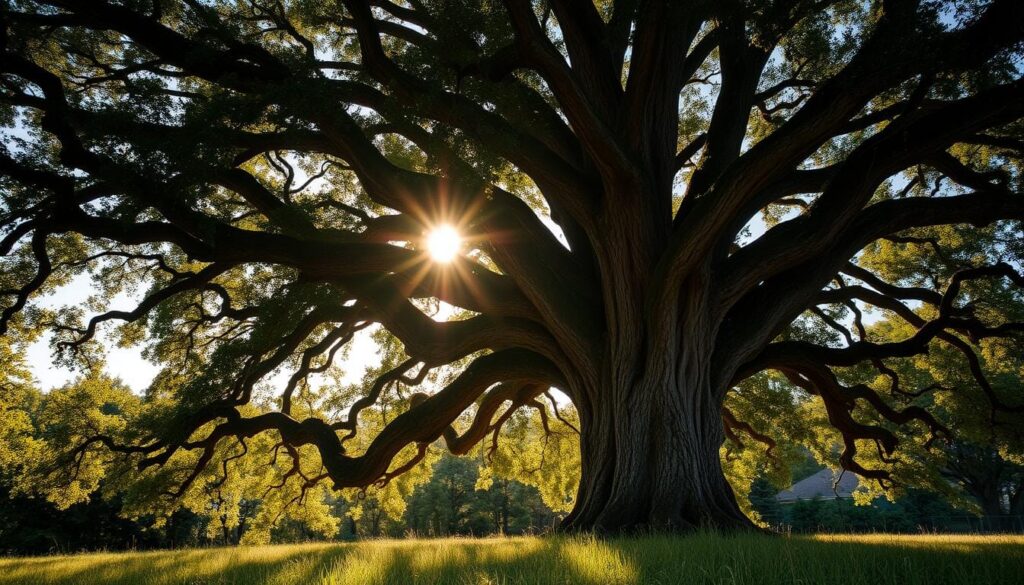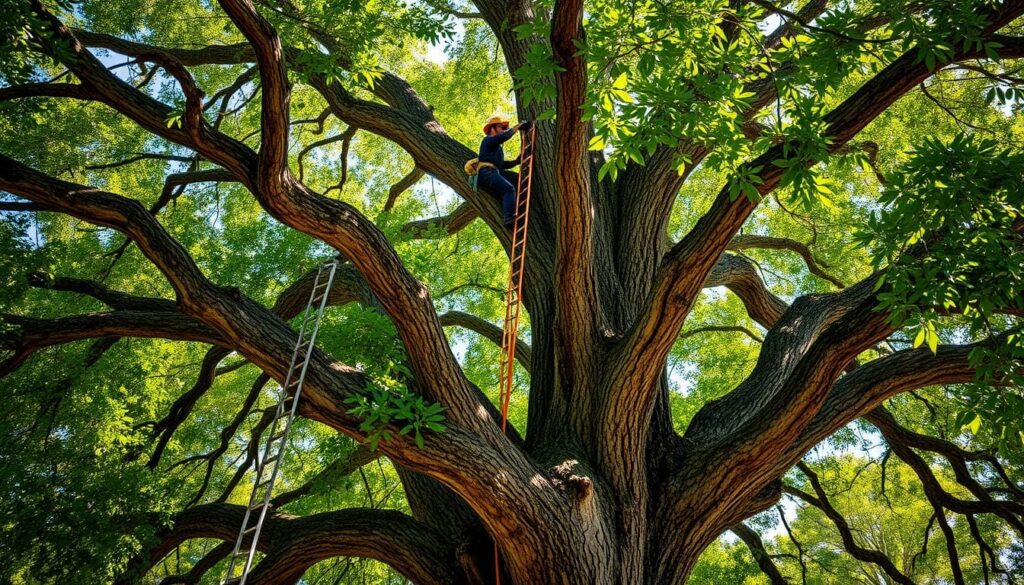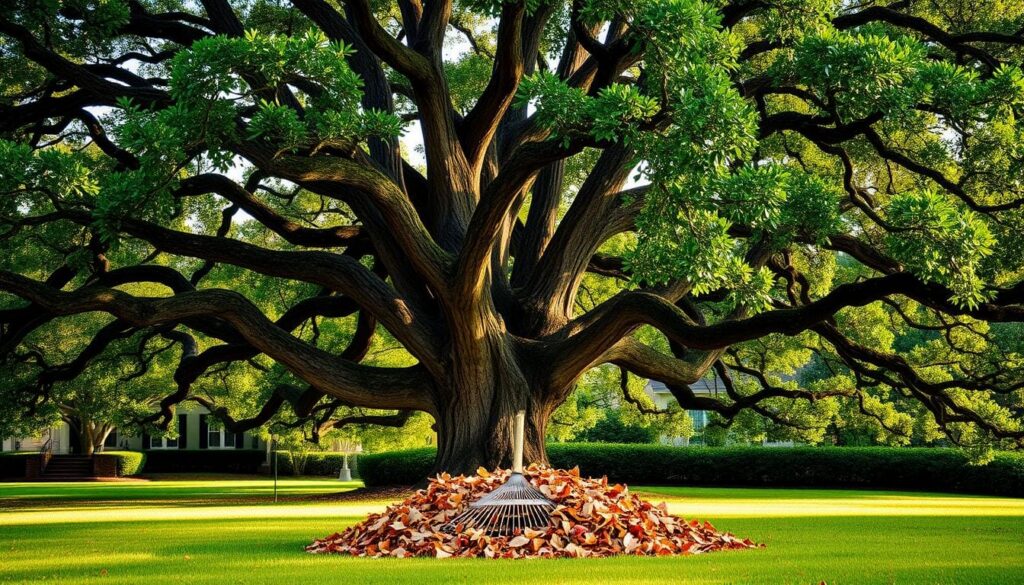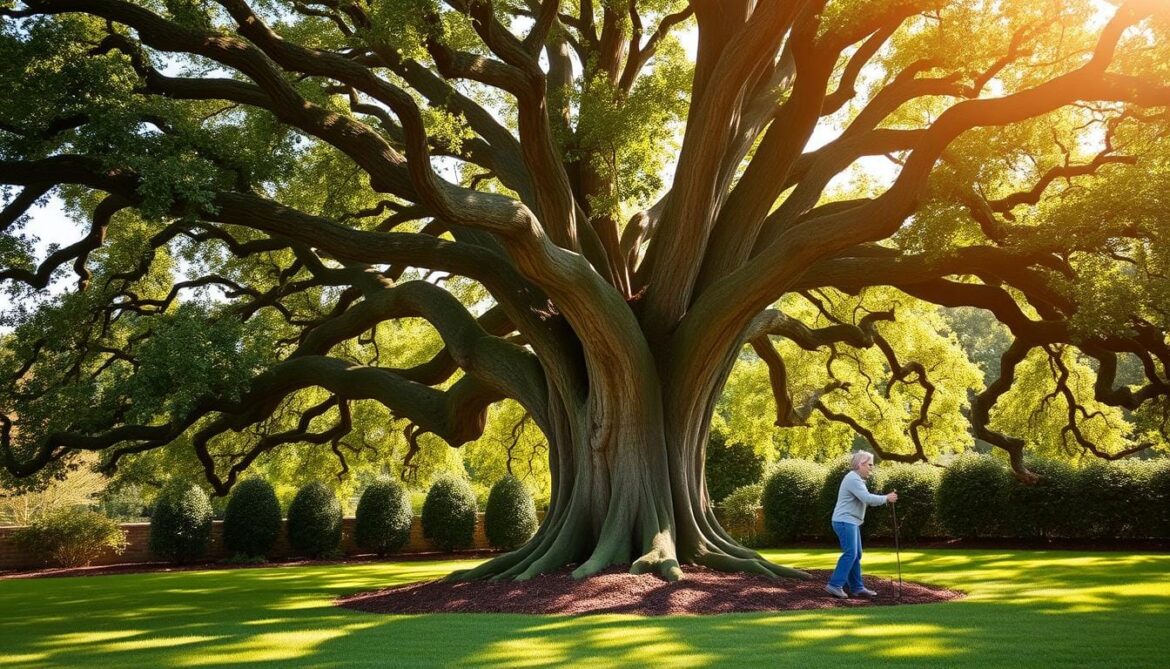Live oak trees are majestic symbols of the southern landscape, with some having stood for hundreds of years. Their sprawling branches and evergreen foliage make them not just natural wonders but also historical treasures.
These iconic trees add significant value and beauty to any property, making their care and preservation crucial. Proper tree care is essential to maintain their health and prolong their lifespan. Understanding the unique characteristics and needs of oak trees is vital for their maintenance.
By following this comprehensive guide, you’ll learn how to provide the best care for your live oak, ensuring it thrives for generations. Whether you’re a homeowner with a historic tree or planning to plant a new one, this guide covers essential practices for maintaining healthy, beautiful trees.
Key Takeaways
- Understand the unique characteristics of live oak trees and their needs.
- Learn essential care practices, including watering and mulching techniques.
- Discover how to identify and solve common problems affecting live oaks.
- Implement seasonal maintenance practices to ensure tree health.
- Gain insights into proper pruning methods for structural integrity.
Understanding Live Oak Trees

Live oaks have been a silent witness to centuries of history, making them an integral part of the cultural identity in regions like Florida. These majestic trees are not just remarkable for their longevity but also for the numerous benefits they provide to the environment and the community.
Characteristics and Lifespan of Live Oaks
Live oaks are distinguished by their distinctive features and remarkable growth patterns.
Distinctive Features
The live oak is known for its sprawling canopy and sturdy branches, often draped with Spanish moss, creating a dramatic and picturesque landscape.
Growth Patterns and Longevity
These oak trees are renowned for their slow growth rate and exceptional longevity, with some living for hundreds of years. This long lifespan allows multiple generations to enjoy their beauty and benefits.
The Importance of Live Oaks in the Landscape
Live oaks play a crucial role in the landscape, offering numerous environmental, historical, and aesthetic benefits.
Environmental Benefits
- Provide habitat for diverse wildlife, including birds and mammals that feed on their acorns.
- Contribute to oxygen production and carbon sequestration, enhancing air quality.
- Support biodiversity by hosting various epiphytes like Spanish moss.
Historical and Aesthetic Value
Live oaks are not only significant for their environmental benefits but also for their historical and aesthetic value, often becoming landmarks in their communities and enhancing property values.
Essential Live Oak Care Practices
Caring for a live oak requires attention to its specific needs, including watering, mulching, and soil management. By understanding and implementing these essential care practices, you can ensure the health and longevity of your live oak tree.
Watering Requirements
Proper watering is crucial for the health of your live oak. The watering needs vary depending on the age of the tree.
Young Tree Watering
Young live oaks need consistent moisture, especially during their first year. Water them regularly, but avoid overwatering, which can lead to root rot.
Mature Tree Watering
Mature live oaks are more drought-tolerant, but they still benefit from occasional deep watering during prolonged dry spells. This encourages deep root growth and enhances the tree’s resilience.
Mulching Techniques
Mulching is a beneficial practice for live oaks, helping to retain soil moisture, suppress weeds, and regulate soil temperature.
Proper Mulch Application
Apply a 2-3 inch layer of organic mulch around the tree, keeping it a few inches away from the trunk. This helps prevent moisture from accumulating against the bark, reducing the risk of disease.
Benefits of Mulching
Mulching not only improves soil health but also adds to the aesthetic appeal of your landscape. As the mulch breaks down, it adds nutrients to the soil, benefiting the tree.
Soil Management
Live oaks thrive in well-drained, acidic soils. Poor soil conditions can lead to root problems and overall decline.
Ideal Soil Conditions
Live oaks prefer slightly acidic soils with good drainage. They can adapt to various soil types if other care practices are optimized. Ensuring good soil structure supports healthy root development.
Fertilization Guidelines
Native oaks seldom require fertilization, especially if they have been mulched. If the foliage is mottled or lacks a deep green color, light fertilization with nitrogen fertilizer may be beneficial. Soil testing is the best way to determine soil fertility and guide fertilization decisions.
Pruning and Structural Maintenance

To keep your live oak tree healthy and thriving, understanding pruning techniques and structural support is vital. Proper pruning not only enhances the tree’s appearance but also prevents potential hazards by removing weak or damaged branches.
When to Prune Live Oaks
Pruning live oaks requires careful timing to minimize stress and prevent disease. The ideal pruning time is during the dormant season.
Seasonal Considerations
Pruning during late winter or early spring avoids the active growing season, reducing the risk of pest infestation and disease.
Age-Based Pruning Schedule
Young live oaks benefit from regular pruning to establish a strong structure, while mature trees require less frequent but more targeted pruning.
Proper Pruning Techniques
Effective pruning involves selecting the right branches to remove and using proper cutting methods to minimize damage.
Branch Selection
Identify and remove branches that are dead, diseased, or structurally unsound to maintain the tree’s health and safety.
Cutting Methods
Use clean, sharp tools to make precise cuts, reducing the risk of infection and promoting healthy healing.
Structural Support for Mature Trees
Mature live oaks with heavy limbs or structural weaknesses may benefit from supplemental support systems like cabling and bracing.
Cabling and Bracing
These techniques, performed by a professional arborist, can help stabilize the tree and prevent branch failure.
Post-Storm Maintenance
After severe weather, inspect your live oak for damage and prune broken branches to prevent further harm.
Identifying and Addressing Common Live Oak Problems

Live oaks, though resilient, face numerous challenges that can impact their health and longevity. These challenges can range from diseases and pest infestations to environmental stressors.
Disease Management
Diseases can significantly impact the health of live oaks. Two major disease-related issues are oak wilt and fungal infections.
Oak Wilt Prevention and Treatment
Oak wilt is a serious disease that can kill live oaks. Prevention involves avoiding wounding trees during critical periods and using proper pruning techniques. Treatment often requires professional arboricultural services.
Fungal Infections
Fungal infections can cause root rot, canker, and other issues in live oaks. Maintaining tree health through proper watering and mulching can help prevent these infections.
Pest Control
Pests are another significant threat to live oak health. Common pests include various insects that can cause damage.
Common Insect Pests
Insects such as the oak lace bug and twig pruner can cause significant damage. Monitoring tree health regularly can help identify pest issues early.
Natural and Chemical Control Methods
Control methods range from natural approaches, like introducing beneficial insects, to chemical treatments. The choice of method depends on the severity of the infestation and environmental considerations.
Environmental Stressors
Environmental factors, including drought, flooding, and extreme temperatures, can stress live oaks, making them more susceptible to disease and pests.
Drought Stress
Signs of drought stress include leaf wilting, premature leaf drop, and branch dieback. Proper watering and mulching can help mitigate drought stress.
Construction Damage Prevention
Construction activities can damage live oak roots, leading to long-term health issues. Protecting the root protection zone (RPZ) is crucial. This involves avoiding soil compaction, trenching, and grade changes within the RPZ.
By understanding and addressing these common problems, live oak tree owners can take steps to ensure the long-term health and longevity of their trees.
Seasonal Live Oak Care

To keep your live oak thriving, it’s essential to understand the specific care practices needed for each season.
Spring Care Routine
Spring is a critical time for oak care. Begin with a post-winter assessment to identify any damage or disease that may have occurred during the colder months.
Post-Winter Assessment
Inspect your tree for signs of stress, disease, or pest infestation. Look for damaged or dead branches that need pruning.
Spring Treatments
Apply necessary treatments, such as fertilizers or pest control measures, to promote healthy growth and prevent disease.
Summer Maintenance
During the summer, live oaks require careful management to withstand heat and drought.
Heat and Drought Management
Ensure your tree receives adequate water, especially during dry spells. Mulching around the base can help retain moisture.
Summer Pest Monitoring
Regularly inspect your oak for signs of pests, such as scale or aphids, and treat promptly if necessary.
Fall and Winter Care
As fall approaches, prepare your live oak for the colder months by ensuring it’s well-hydrated and free from debris.
Preparing for Dormancy
Remove fallen leaves and debris to prevent fungal growth and reduce the risk of disease.
Winter Protection Measures
In colder regions, protect young or recently planted trees from frost damage. Prune dead wood and inspect the tree for any signs of disease or damage.
Conclusion: Ensuring the Long-Term Health of Your Live Oak
By synthesizing the insights from this guide, you’ll be able to craft a care plan that addresses the specific needs of your live oak tree. Proper care practices, including watering, mulching, and pruning, are crucial for maintaining the health and beauty of these majestic trees. Regular inspection and maintenance routines can prevent common problems, ensuring your live oak remains a vibrant part of the landscape. For expert care and personalized solutions, consider consulting a certified arborist who specializes in oak care. With informed care, your live oaks will continue to thrive for generations, standing as proud symbols of strength and beauty.

